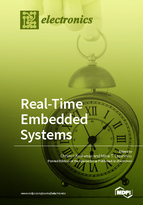Real-Time Embedded Systems
A special issue of Electronics (ISSN 2079-9292). This special issue belongs to the section "Computer Science & Engineering".
Deadline for manuscript submissions: closed (31 January 2018) | Viewed by 73047
Special Issue Editors
Interests: real-time distributed embedded systems; wired/wireless industrial networks; industrial IoT; WSN/RFID systems
Special Issues, Collections and Topics in MDPI journals
Interests: reusable WSN/IoT platforms; sensing, indoor localization, and data processing for IoT; design for low power; embedded machine learning and neural networks; high-level HW/SW co-design; high-level synthesis
Special Issues, Collections and Topics in MDPI journals
Special Issue Information
Dear Colleagues,
Real-time and networked embedded systems are crucial bridges between the physical and the information worlds in the ever growing embedded intelligence pervasiveness in industry, infrastructure, and in public and private spaces. They have been identified as society and economy emerging “neural systems”, and as one of the next big concepts supporting societal changes and economic growth. Intelligence is increasingly embedded in everyday life connected objects, fostered by cost/performance improvements and by the spread to wider application fields of the specialized technologies and engineering disciplines once tightened in silo domains. While this process gradually builds the IoT, it starts to expose non trivial timing and other extra functional requirements and system properties, which are less common to typical computing.
This Special Issue is dedicated to the specificities of cyberphysical and real time embedded systems that are present both in traditional relevant application domains, such as industrial automation and control, energy management, automotive, aerospace and defense systems, as well as in emerging domains, such as in medical devices, household appliances, mobile multimedia, gaming, and entertainment systems. We solicit state-of-the-art original research contributions in topics that include, but are not limited to:
- Industrial use-cases and applications of real-time embedded systems: design, implementation and performance evaluation
- Modeling, formal methods, simulation and development tools for real-time and networked embedded systems
- Real-time embedded systems design: energy management, dynamic reconfiguration, QoS, heterogeneity and interoperability
- Formal methods, timing analysis, scheduling design, analysis and verification
- Hardware/software co-design, synthesis, reconfigurable hardware, real-time network- and system on chip
- Wireless sensor networks (WSNs), RFID and time-sensitive components and applications
- Real-time networks, network management and time synchronization
- Real-time embedded operating systems (RTOS) and middleware, resource management, resource usage optimization
- Real-time virtualization and hypervisors, real-time Java and Linux for embedded systems
- Security, dependability and fault tolerance of real-time and distributed embedded systems
Dr. Christos Koulamas
Dr. Mihai Teodor Lazarescu
Guest Editors
Manuscript Submission Information
Manuscripts should be submitted online at www.mdpi.com by registering and logging in to this website. Once you are registered, click here to go to the submission form. Manuscripts can be submitted until the deadline. All submissions that pass pre-check are peer-reviewed. Accepted papers will be published continuously in the journal (as soon as accepted) and will be listed together on the special issue website. Research articles, review articles as well as short communications are invited. For planned papers, a title and short abstract (about 100 words) can be sent to the Editorial Office for announcement on this website.
Submitted manuscripts should not have been published previously, nor be under consideration for publication elsewhere (except conference proceedings papers). All manuscripts are thoroughly refereed through a single-blind peer-review process. A guide for authors and other relevant information for submission of manuscripts is available on the Instructions for Authors page. Electronics is an international peer-reviewed open access semimonthly journal published by MDPI.
Please visit the Instructions for Authors page before submitting a manuscript. The Article Processing Charge (APC) for publication in this open access journal is 2400 CHF (Swiss Francs). Submitted papers should be well formatted and use good English. Authors may use MDPI's English editing service prior to publication or during author revisions.







